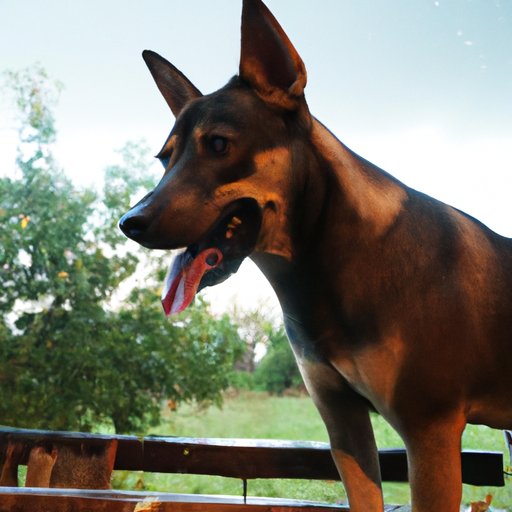I. Introduction
When thunder rumbles, many dogs whimper, hide, or even become destructive. This fear of thunder, also known as astraphobia, is quite common among dogs, and can cause distress to both pets and their owners. If you’ve ever wondered why your dog is scared of thunder, this article will explore the scientific reasoning behind this fear. Moreover, we’ll share crucial tips and strategies for calming terrified dogs during thunderstorms, and explain the impact of untreated thunder phobia in dogs.
II. Scientific Reasoning Behind Dogs’ Fear of Thunder
A growing body of evidence suggests that fear of thunder in dogs stems from a combination of physical factors and psychological conditioning. For instance, thunder produces loud noises that trigger a stress response in dogs, causing their heart rate and cortisol levels to spike. A dog’s sensitive hearing may also play a role in their fear of thunder, as they might hear sounds of thunder before humans do. Additionally, dogs may associate thunder with other unpleasant experiences, like lightning, rain, and strong winds, leading to learned fear or environmental conditioning.
III. Personal Experiences of Pet Owners and Trainers
Real-life accounts of dealing with dogs scared of thunder are incredibly diverse. Some dog owners report that their dogs pant and pace around the house, while others hide in closets or under the bed. Some pet owners turn to dog trainers or behavioral experts to help their distressed pets. These professionals use a variety of methods, including counter-conditioning and desensitization, to help dogs learn to tolerate or overcome their fear of thunder.
IV. Tips and Strategies for Calming Terrified Dogs During Thunderstorms
Several techniques can help calm dogs who are anxious and scared during thunderstorms. Behavioral training techniques such as counter-conditioning involve exposing the dog to sounds of thunder at low volumes and then gradually increasing the level over time. Additionally, some products, including compression vests, pheromone sprays, and sound-dampening earmuffs, can help reduce a dog’s fear and anxiety. Veterinarians may also prescribe anti-anxiety or sedative medications for dogs with severe thunder phobia. Also, dedicated safe spaces where they can retreat to during thunderstorms can help soothe them.
V. Genetics and Breed Tendencies in Fear of Thunder
Some dogs may be more likely to experience thunder phobia than others due to genetics or breed tendencies. For example, some dog breeds are more susceptible to noise sensitivity than others, including retrievers, herding breeds, hounds, and Bichons. Moreover, puppies from puppy mills or rescued dogs who have previous experiences of trauma are more likely to suffer from thunder phobia due to lack of early socialization. It’s crucial to understand that a dog’s genetic predisposition or past trauma does not mean that he or she has to suffer from thunder phobia. With early socialization and proper training, these dogs can learn to tolerate or overcome fear from thunder.
VI. Importance of Early Socialization and Exposure to Thunder and Loud Noises
Early socialization and exposure to thunder and loud noises in a safe and controlled environment may help prevent or mitigate thunder phobia in dogs. By creating a positive association with loud noises, puppies learn that they need not be frightened and respond calmly when exposed to loud noises in their future. You can help your puppies overcome anxiety through a systematic and gradual approach that involves rewards, positive reinforcement and desensitization techniques.

VII. Consequences of Untreated Storm Phobia in Dogs
Untreated thunder phobia can have severe consequences for dogs’ health and wellbeing. Dogs with untreated thunder phobia are prone to destructive behavior, self-injury, and may even run away from their homes. Consistent exposure to stress and anxiety can cause physiological damage to their liver, heart, and brain, which can lead to several chronic diseases and a decreased lifespan.
VIII. Alternative Options for Helping Dogs Cope with Thunder
Aside from medication and behavioral training techniques, several alternative therapies can help dogs deal with their fear of thunder. One such method is white noise or sound therapy, where pet owners use white noise machines to drown out thunder and other loud noises. Sound therapies, including classical music, have proven to help dogs relax and lower heart rate and stress levels.
IX. Conclusion
It’s no surprise that dog owners want to help their pets overcome their fear of thunder and lead anxiety-free lives. Fortunately, with proper socialization and training, medication, and other techniques, thunder phobia can be managed or overcome. For dog owners looking to help their fur babies, the best approach is a combination of medication, behavioral therapy, and alternative treatments, such as sound therapy. Always reaching out to your dog’s vet for help. By seeking help and understanding the science behind it, dog owners can help their pets navigate this common phobia.
